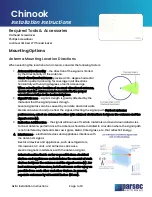
OBID
®
Antenna Manual
ID RW24
FEIG ELECTRONIC GmbH
Seite 14 von 15
h80391-1e-ID.doc
5. Influences on the ID RW24-systems
There are two main kinds of environmental influences on an ID RW24-system. On the one hand,
there is the influence of metallic objects in close proximity to the antennas. On the other hand, the
system is influenced by electronic appliances, which impair the reception of the RW24-system by
irradation of magnetic fields into the antenna.
If metallic objects are situated close to the antenna, this will lead to a detuning of the antenna and to
a weakening resp. change in the antenna field intensity. Detuning of the antenna may be leveled out
by an automatic antenna tuner, but the weakening resp. change in the field intensity may lead to
substantial range losses. In order to avoid such effects, no metallic objects should be situated within
a distance of 30 cm around the antenna. The second type of disturbance are electronic appliances,
which produce magnetic fields in the frequency ranges of the carrier frequency (125 kHz) or the data
rate (2 - 8 kHz) of the reader. One extreme example are PC-monitors, who’s magnetic picture tube
units may produce substantial disturbances, depending on their resolution and display rate.
5.1. Mutual influence of two ID RW24-systems
If the antennas of two ID RW24-systems are mounted in close proximity to each other, which means
in a distance of only some meters, a mutual influence is very likely. We distinguish two kinds of influ-
ence:
•
by carrier frequencies
•
by transmission logs.
5.1.1. Mutual influence by carrier frequencies
An influence on two systems by carrier frequencies makes itself felt by an interference with the dif-
ference frequency of the two systems on the corresponding carrier. This influence may lead to the
situation that both readers are unable to communicate with transponders. One possible remedy for
this is to increase the distance between the two antennas or to protect the antennas with a metallic
shield (see also chapter 5.2.2).
The minimum distance between two gate antennas with a shield size of 50 cm x 70 cm should be at
least 2,5 m, so that the disturbances will not impair the recognition rate in a non-acceptible way.
5.1.2. Mutual influence by transmission logs
An even more serious kind of disturbance is caused by transmission logs of neighbouring antennas.
Depending on the antenna size, the minimum distance between two antennas of noughbouring sys-
tems may exceed 10 m.
A metallic shield for the protection against this kind of disturbance would, depending on the type and
size of the antenna, need dimensions, which cannot be realized in practical operation. For example,
a shroud with an acceptable disturbance supression would need a projecting end of 20 cm on all
sides, if located at a distance of approx. 15 cm from the antenna. However, these values depend
highly on the application and have to be detected by trial.

































